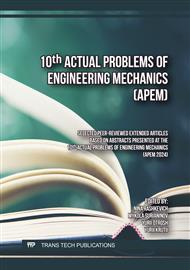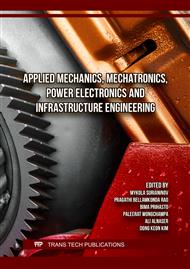[1]
Sadkovyi, V., Andronov, V., Semkiv, O., Kovalov, A., Rybka, E., Otrosh, Yu. et. al.; Sadkovyi, V., Rybka, E., Otrosh, Yu. (Eds.) (2021). Fire resistance of reinforced concrete and steel structures. Kharkiv: РС ТЕСHNOLOGY СЕNTЕR, 180.
DOI: 10.15587/978-617-7319-43-5
Google Scholar
[2]
Loboichenko, V., Nikitina, N., Leonova, N., Konovalova, O., Bondarenko, A., Zemlianskyi, O., Rashkevich, N. Study of the features of determination of heavy metals in bottom sediments. In IOP Conference Series: Earth and Environmental Science, 1348 (1) (2024) p.012014.
DOI: 10.1088/1755-1315/1348/1/012014
Google Scholar
[3]
Kovalov, A., Otrosh, Y., Vedula, S., Danilin, O., Kovalevska, T. (2019). Parameters of fire-retardant coatings of steel constructions under the influence of climatic factors. Naukovyi Visnyk Natsionalnoho Hirnychoho Universytetu, 3, 46–53.
DOI: 10.29202/nvngu/2019-3/9
Google Scholar
[4]
Kovalov, A., Purdenko, R., Otrosh, Y., Tоmеnkо V., Rashkevich, N., Shcholokov, E., Pidhornyy, M., Zolotova, N., & Suprun, O. Assessment of fire resistance of fireproof reinforced concrete structures. Eastern-European Journal of Enterprise Technologies, 5 (1 (119)) (2022) 53–61.
DOI: 10.15587/1729-4061.2022.266219
Google Scholar
[5]
Otrosh, Y., Rybka, Y., Danilin, O., Zhuravskyi, M. Assessment of the technical state and the possibility of its control for the further safe operation of building structures of mining facilities. EDP Sciences. In E3S Web of Conferences. 123 (2019) 01012.
DOI: 10.1051/e3sconf/201912301012
Google Scholar
[6]
Bashynska, O., Otrosh, Y., Holodnov, O., Tomashevskyi, A., & Venzhego, G. Methodology for Calculating the Technical State of a Reinforced-Concrete Fragment in a Building Influenced by High Temperature. Materials Science Forum, 1006 (2020)166–172.
DOI: 10.4028/www.scientific.net/msf.1006.166
Google Scholar
[7]
Deng, L., Wang, W., & Yu, Y. State-of-the-art review on the causes and mechanisms of bridge collapse. Journal of Performance of Constructed Facilities, 30(2) (2016) 04015005.
DOI: 10.1061/(asce)cf.1943-5509.0000731
Google Scholar
[8]
Naser, M. Z., Hawileh, R. A., & Abdalla, J. A. Fiber-reinforced polymer composites in strengthening reinforced concrete structures: A critical review. Engineering Structures, 198 (2019) 109542.
DOI: 10.1016/j.engstruct.2019.109542
Google Scholar
[9]
Andrii Kovalov, Yurii Otrosh, Oleksandr Chernenko, Maxim Zhuravskij, Marcin Anszczak (2021). Modeling of Non-Stationary Heating of Steel Plates with Fire-Protective Coatings in Ansys under the Conditions of Hydrocarbon Fire Temperature Mode. In Materials Science Forum. Trans Tech Publications Ltd. Volume 1038 - pp.514-523.
DOI: 10.4028/www.scientific.net/msf.1038.514
Google Scholar
[10]
Razmi, J.; McCabe, M. Analytical and Computational Modeling of Integral Abutment Bridges Foundation Movement due to Seasonal Temperature Variations. Int. J. Geomech. 20 (2020) 04019189.
DOI: 10.1061/(asce)gm.1943-5622.0001622
Google Scholar
[11]
Fang, J., Ishida, T., Fathalla, E., & Tsuchiya, S. Full-scale fatigue simulation of the deterioration mechanism of reinforced concrete road bridge slabs under dry and wet conditions. Engineering Structures. 245 (2021) 112988.
DOI: 10.1016/j.engstruct.2021.112988
Google Scholar
[12]
Akiyama, M., Matsuzaki, H., Dang, H. T., & Suzuki, M. Reliability-based capacity design for reinforced concrete bridge structures. Structure and Infrastructure Engineering. 8(12) (2012) 1096-1107.
DOI: 10.1080/15732479.2010.507707
Google Scholar
[13]
N. Rashkevich, R. Shevchenko, I. Khmyrov, A. Soshinskiy Investigation of the Influence of the Physical Properties of Landfill Soils on the Stability of Slopes in the Context of Solving Civil Security Problems, Materials Science Forum, 1038 (2021) 407–416.
DOI: 10.4028/www.scientific.net/msf.1038.407
Google Scholar
[14]
Akiyama, M., Frangopol, D. M., & Ishibashi, H. Toward life-cycle reliability-, risk-and resilience-based design and assessment of bridges and bridge networks under independent and interacting hazards: emphasis on earthquake, tsunami and corrosion. Structure and Infrastructure Engineering, 16(1) (2020) 26-50.
DOI: 10.1080/15732479.2019.1604770
Google Scholar
[15]
Miyata, T., Yokoyama, K., Yasuda, M., & Hikami, Y. Akashi Kaikyo Bridge: Wind effects and full model wind tunnel tests. In Aerodynamics of large bridges. (2017) 217-236.
DOI: 10.1201/9781315136950-16
Google Scholar
[16]
Cao, R.; Agrawal, A.K.; El-Tawil, S. Overheight Impact on Bridges: A Computational Case Study of the Skagit River Bridge Collapse. Eng. Struct. 237 (2021) 112215.
DOI: 10.1016/j.engstruct.2021.112215
Google Scholar
[17]
Mu, H.; Zheng, Z.; Wu, X.; Su, C. Bayesian Network-Based Modal Frequency–Multiple Environmental Factors Pattern Recognition for the Xinguang Bridge Using Long-Term Monitoring Data. J. Low Freq. Noise Vib. Act. Control. 39 (2018) 545–559.
DOI: 10.1177/1461348418786520
Google Scholar
[18]
G.C. Lee, S.B. Mohan, C. Huang, et al. A Study of U.S. Bridge Failures (1980-2012). State University of New York at Buffalo, New York (2013).
Google Scholar
[19]
Deng, L., Yu, Y., Zou, Q., & Cai, C. S. State-of-the-art review of dynamic impact factors of highway bridges. Journal of Bridge Engineering, 20(5) (2015) 04014080.
DOI: 10.1061/(asce)be.1943-5592.0000672
Google Scholar
[20]
Skob Y., Dreval Y., Vasilchenko A., Maiboroda R. Selection of Material and Thickness of the Protective Wall in the Conditions of a Hydrogen Explosion of Various Power. Key Engineering Materials, 952 (2023) 121-129.
DOI: 10.4028/p-st1vet
Google Scholar
[21]
El-Tawil, S.; Severino, E.; Fonseca, P. Vehicle Collision with Bridge Piers. J. Bridg. Eng. 2005, 10, 345–353.
DOI: 10.1061/(asce)1084-0702(2005)10:3(345)
Google Scholar
[22]
Pasternak, V., Ruban, A., Surianinov, M., Otrosh, Y., & Romin, A. Software Modeling Environment for Solving Problems of Structurally Inhomogeneous Materials. 1068 (2022) p.215–222.
DOI: 10.4028/p-h1c2rp
Google Scholar
[23]
Kodur, V. K. R., & Naser, M. Z. Importance factor for design of bridges against fire hazard. Engineering Structures, 54 (2013) 207-220.
DOI: 10.1016/j.engstruct.2013.03.048
Google Scholar
[24]
Kovalov A., Otrosh Y., Rybka E., Kovalevska T., Togobytska V. and Rolin I. Treatment of Determination Method for Strength Characteristics of Reinforcing Steel by Using Thread Cutting Method after Temperature Influence. In Materials Science Forum. 1006 (2020) pp.179-184.
DOI: 10.4028/www.scientific.net/msf.1006.179
Google Scholar
[25]
K. Tsytlishvili, N. Rashkevich, D. Poltavska, Research of Modern technologies of Wastewater Treatment of Food Products Combined with Ozonation and Hydrogen Peroxide, Key Engineering Materialsthis link is disabled, 925 (2022) 169–178.
DOI: 10.4028/p-t5m3y6
Google Scholar
[26]
Menga, A., Kanstad, T., Cantero, D., Bathen, L., Hornbostel, K., & Klausen, A. Corrosion‐induced damages and failures of posttensioned bridges: A literature review. Structural Concrete, 24(1) (2023) 84-99.
DOI: 10.1002/suco.202200297
Google Scholar
[27]
Akiyama, M., & Frangopol, D. M. Long-term seismic performance of RC structures in an aggressive environment: Emphasis on bridge piers. In Structures and Infrastructure Systems. (2019) pp.239-253.
DOI: 10.1201/9781351182805-16
Google Scholar
[28]
Saadeghvaziri, M. A., & Hadidi, R. Transverse cracking of concrete bridge decks: Effects of design factors. Journal of Bridge Engineering, 10(5) (2005) 511-519.
DOI: 10.1061/(asce)1084-0702(2005)10:5(511)
Google Scholar
[29]
Han, Q., Qin, L., & Wang, P. Seismic failure of typical curved RC bridges in Wenchuan Earthquake. In International efforts in lifeline earthquake engineering. (2013) pp.425-432.
DOI: 10.1061/9780784413234.055
Google Scholar
[30]
Whitlow, R.D.; Haskins, R.; McComas, S.L.; Crane, C.K.; Howard, I.L.; McKenna, M.H. Remote Bridge Monitoring Using Infrasound. J. Bridge Eng. 24 (2019) 04019023.
DOI: 10.1061/(asce)be.1943-5592.0001375
Google Scholar
[31]
Feng, D.; Feng, M.Q. Experimental Validation of Cost-Effective Vision-Based Structural Health Monitoring. Mech. Syst. Signal Process. 88 (2017) 199–211.
DOI: 10.1016/j.ymssp.2016.11.021
Google Scholar
[32]
Estes, A. C., & Frangopol, D. M. Updating bridge reliability based on bridge management systems visual inspection results. Journal of Bridge Engineering, 8(6) (2003) 374-382.
DOI: 10.1061/(asce)1084-0702(2003)8:6(374)
Google Scholar
[33]
Reagan, D., Sabato, A., & Niezrecki, C. Feasibility of using digital image correlation for unmanned aerial vehicle structural health monitoring of bridges. Structural Health Monitoring, 17(5) (2018) 1056-1072.
DOI: 10.1177/1475921717735326
Google Scholar
[34]
Limongelli, M.P. Damage Localization Through Vibration Based S2HM: A Survey. In Environmental and Human Impact of Buildings; Springer Science and Business Media LLC: Berlin/Heidelberg, Germany; (2019) 217–235.
DOI: 10.1007/978-3-030-13976-6_9
Google Scholar
[35]
Jo, H.; Park, J.W.; Spencer, B.F., Jr.; Jung, H.J. Development of high-sensitivity wireless strain sensor for structural health monitorng. Smart Struct. Syst. 11 (2013) 477–496.
DOI: 10.12989/sss.2013.11.5.477
Google Scholar
[36]
Bahrani, M. K., Vasseghi, A., Nooralizadeh, A., & Zargaran, M. Experimental and analytical study on the proposed retrofit method for concrete bent in ordinary highway bridges in Iran. Journal of Bridge Engineering, 22(6) (2017) 05017004.
DOI: 10.1061/(asce)be.1943-5592.0001045
Google Scholar
[37]
Kovalov, A., Otrosh, Y., Kovalevska, T., & Safronov, S. Methodology for assessment of the fire-resistant quality of reinforced-concrete floors protected by fire-retardant coatings, In Materials Science and Engineering. IOP Publishing, 708 (1) (2019) p.012058.
DOI: 10.1088/1757-899x/708/1/012058
Google Scholar
[38]
S Guzii, Y Otrosh, O Guzii, A Kovalov, K Sotiriadis. Determination of the Fire-Retardant Efficiency of Magnesite Thermal Insulating Materials to Protect Metal Structures from Fire, In Materials Science Forum, 1038 (2021) pp.524-530.
DOI: 10.4028/www.scientific.net/msf.1038.524
Google Scholar



